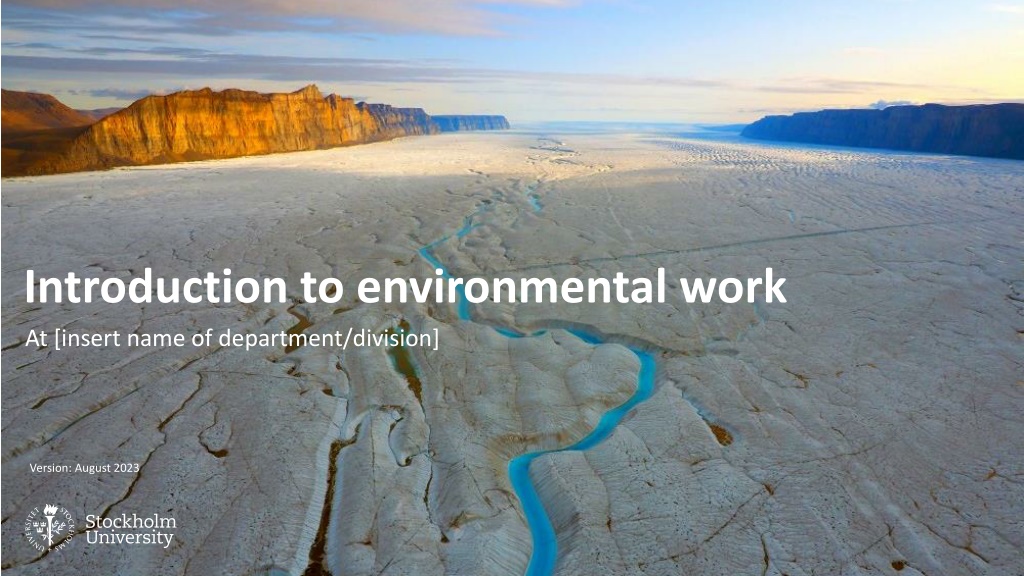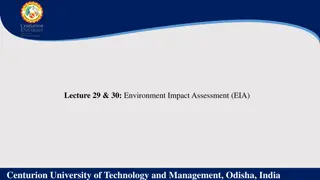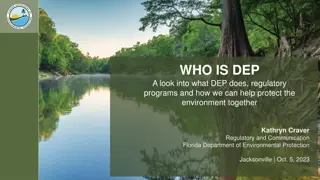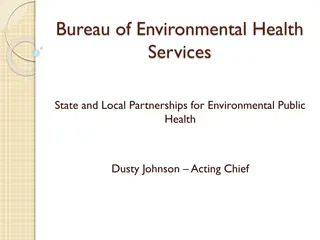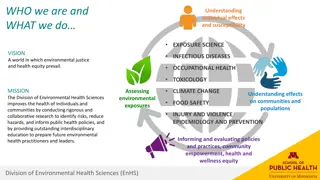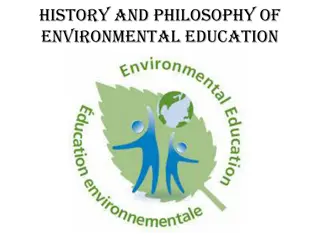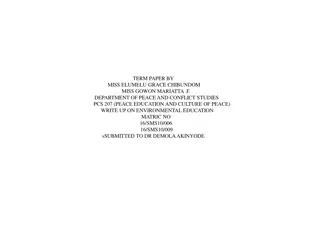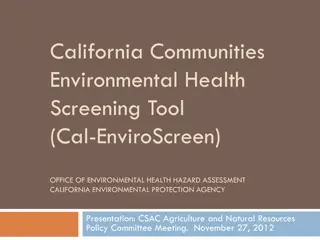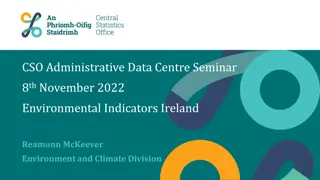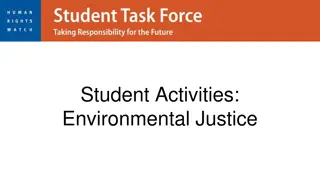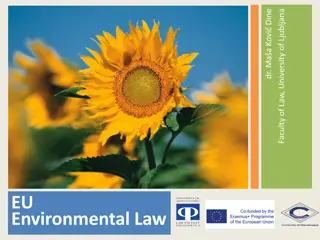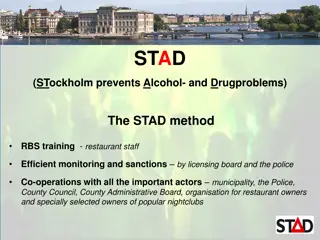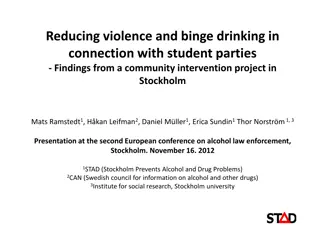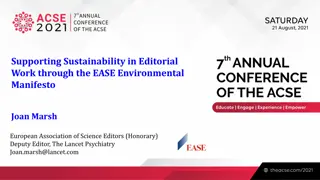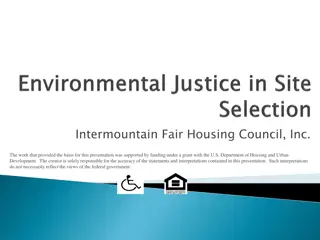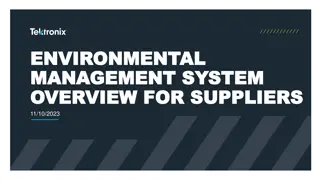Stockholm University Environmental Work Overview
Stockholm University actively engages in environmental work to minimize its negative impact, foster sustainability, and reduce resource use. The university's environmental organization, policies, and collaborations reflect its commitment to environmental stewardship and sustainable development.
Download Presentation

Please find below an Image/Link to download the presentation.
The content on the website is provided AS IS for your information and personal use only. It may not be sold, licensed, or shared on other websites without obtaining consent from the author.If you encounter any issues during the download, it is possible that the publisher has removed the file from their server.
You are allowed to download the files provided on this website for personal or commercial use, subject to the condition that they are used lawfully. All files are the property of their respective owners.
The content on the website is provided AS IS for your information and personal use only. It may not be sold, licensed, or shared on other websites without obtaining consent from the author.
E N D
Presentation Transcript
Introduction to environmental work At [insert name of department/division] Version: August 2023
What you as a new employee need to know Stockholm University contributes to society's knowledge of the environment and sustainable development through education, research and collaboration. At the same time, the university's activities have a negative environmental impact. The University works actively to reduce this environmental impact. To contribute to this, you as an employee need to know: How environmental work at Stockholm University is organized. The content of the University's overall environmental policy and policy for meetings and travel. Information about local environmental work, such as the local environmental action plan, local routines, deviation reporting and waste management in the premises.
The University's environmental organisation Environmental representatives are present at each department and administration office. They coordinate environmental work at local level. There are laboratory coordinators at each department with laboratory activities. There are three environmental coordinators, one for the Human Sciences, one for the Sciences and one for the administration. They support the environmental representatives in each area/administration. The Office of the President has a central environmental function, an environmental coordinator and an environmental controller, who coordinate the entire university's environmental work. At the Property Management Department there is a laboratory safety coordinator and a chemical safety coordinator who coordinates the laboratory activities. The Environmental Council is the overall advisory body to the President on environmental issues. The Senior advisor for the President on Environment and Sustainable Development leads the Environmental Council and environmental work at the University.
Stockholm University's environmental policy Knowledge and awareness: Integrate environmental and sustainability issues in education. Convey current environmental and sustainability research that is conducted. Resource use and emissions: Minimize negative environmental impacts, increase biodiversity on campus and reduce natural resource use. Through the Climate Roadmap, work to reduce the carbon footprint and achieve carbon neutrality by 2040. Set requirements: Work for higher environmental ambitions than the university's binding requirements. Take the environment and climate into account in decision-making. Continued on next page
Stockholm University's environmental policy Collaboration: Collaborate with stakeholders for a good environment, sustainable societal development and climate transition. Encourage: Encourage and create conditions for staff and students to contribute to work related to the environment and sustainable development. Evaluate: Continuously evaluate and improve environmental work. The entire policy can be found on the Staff web
Meetings and Travel Policy Evaluate: Carefully evaluate the need for a business trip or as part of the training. Digital meetings: Travel should, as far as possible, be replaced with digital forms of meetings. Not allowed to fly to a meeting or activity lasting less than one working day if digital participation can be offered. Minimizing emissions: Priority is given to means of transport that generate the lowest greenhouse gas emissions such as trains over planes. Continued on next page
Meetings and Travel Policy Journeys shorter than 700 kilometers: Unless there are special reasons, means of transport other than air must be used for journeys of less than 700 kilometers. Local traffic: For local journeys in Sweden or abroad, public transport should primarily be used, secondarily taxis (with green cars) or other terrestrial traffic with lower carbon dioxide emissions. The entire policy is available on the Staff web
Climate Roadmap Towards carbon neutrality by 2040
Carbon neutral emission target by 2040 50 45 40 35 30 Kiloton CO2e 25 20 Net zero greenhouse gas emissions by 2040 Desired developments: Five percent decrease per year compared to 2019 15 10 5 0 2019 2025 2030 2035 2040
Priority areas for managing our own emissions Business travel: Buildings and facilities: Make use of existing premises over new construction Facility optimization Climate considerations in the construction process Energy saving measures Reduce emissions from air travel by 25% by 2025 Improved support for digital meetings, workshops, dissertations and conferences Improve the choice of terrestrial alternatives to air travel Goods and services: Coordinating transport Reuse and extend service life Central system for reuse
Local environmental work At [insert name of department/division]
Environmental impact at [name of department/division] Our significant environmental impact (negative or positive) is: Negative [Chemical use/gas consumption] [Reuse, recycling, waste] [Travel, transport and tools] [Consumption] [Buildings and premises] Positive [Core activities: education, research and collaboration] [Competence development internally]
Department/division's carbon dioxide emissions [year] [Insert a picture of your department/division's distribution of emissions from: https://carbonintelligence.svalna.se/]
Environmental Action Plan for [name of Department/Administrative Office] [year] [Link to the department's environmental action plan, or paste a picture of it]
Local environmental practices [List any local routines that are important for employees to be aware of, such as in waste, recycling, handling of chemicals, purchasing catering, travel]
To report environmental deviations or submit suggestions for improvement An environmental deviation is a deviation from environmental legislation, the University's local rules and procedures or the University's environmental management system. Environmental deviations must be reported in IA, regardless of whether they have occurred at local level - at a department, for example, or in one of the university's common areas. A proposal for improvement can be, for example: more bicycle rooms, easier to book international train journeys, concrete proposals to reduce energy consumption. Improvements to the overall environmental performance are reported in IA.
More information about the university's Environmental work is available at su.se/sustainablecampus
